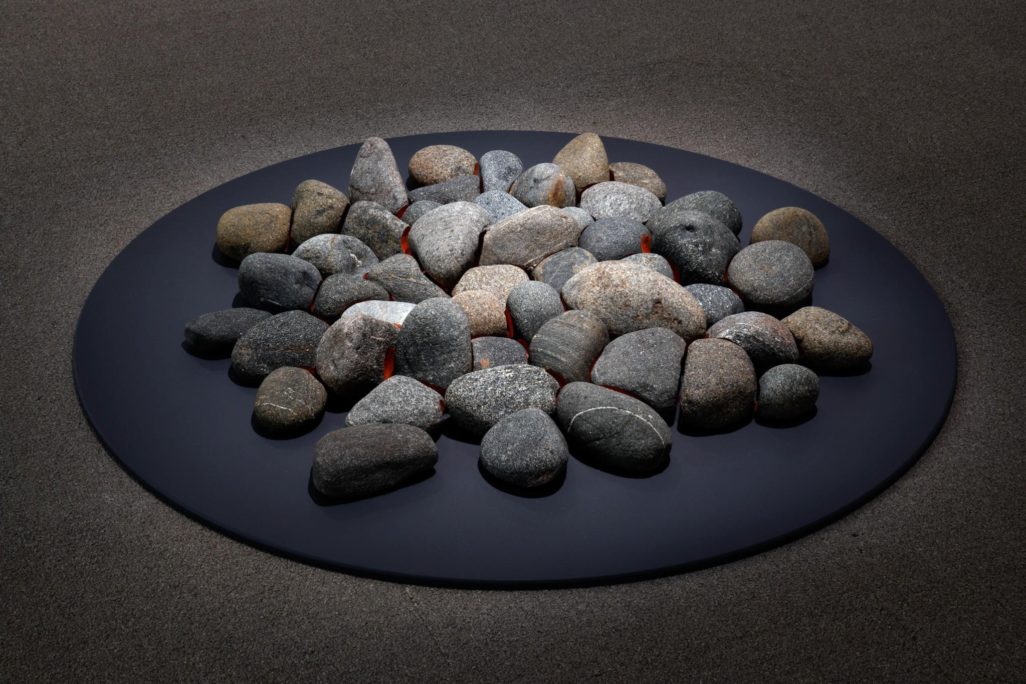Studio Sunday: Michael Belmore: Smoulder
About
Michael Belmore is an Anishinaabe artist from the Obishikokaang (Lac Saul) First Nation. His artwork has been shown across Canada and internationally. He makes sculptures using many natural materials and thinks about how materials interact with each other, how they interact with nature, and how people interact with them.
About the Artwork
There are several layers of thought to the way Michael Belmore uses natural materials in his work. Take just one of those materials- the gleaming copper you can see on the carved edges of the rocks. It has several meanings:
- In Anishinaabe beliefs, copper is thought to be the blood of two manitous (spirits). The animikiig (or thunderbirds) and the mishibizhiig (or underwater panthers) were said to fight in the places between where their homes met– on the shores of lakes, leaving behind their copper blood.
- Because it is found on lakeshores, and because it is easy to shape, copper is often connected with water.
- Because of the way that it reflects warm light, copper is often connected to fire. This artwork looks like a low, smouldering campfire.
Michael’s artwork often looks at the “in-between” places. Copper can represent the space between the land and sky, the connection between water and fire, and the connection between spirits and the Earth. The copper is placed in between the rocks where they fit together. Even the fact that this fire is smouldering makes us think about an in-between time: the time between it being roaring, and going out.
To learn more about Anishinaabe beliefs about copper and about Michael Belmore’s work, take a look at this catalog from his solo exhibition, mskwi-blood-sang. This resource is in both French and English.
ABOUT THE ARTIST
Michael Belmore is an Anishinaabe artist from the Obishikokaang (Lac Saul) First Nation. His artwork has been shown across Canada and internationally. He makes sculptures using many natural materials and thinks about how materials interact with each other, how they interact with nature, and how people interact with them. “…His work and processes speak about the environment, about land, about water, and what it is to be Anishinaabe . . . Seemingly small things, simple things, inspire Belmore’s work; the swing of a hammer, the warmth of a fire, the persistence of waves on a shore.” (Bio – Michael Belmore )
THINGS TO THINK ABOUT
- We talked about copper, and how many meanings it can have. Can you think about what meanings the rocks in this artwork could hold?
Post your artwork online using the hashtag #studiosundaysyqr!
Studio Activity
Inspired by Michael Belmore’s Smoulder, create a sculpture out of two materials that are important to you.
What you Need:
- Found materials (see instructions)
- Sculptural tools (see instructions)
What you Do:
- Think about what materials are important to you. They might be important because of the way you use them in your everyday life, because of a connection to a specific memory or story, because of a connection to your culture, or event just because you like their look or texture. Some examples could be:
- Wood
- Beads
- Fabric
- Rocks
- Old toys
- Paper
- Dry foods like pasta or beans
- Pick two materials to make a sculpture out of. When collecting your materials for your sculpture, try to think about doing so respectfully. When you take that material, does it affect anyone else? Do you need to ask someone who shares that material with you? Do you need to say thank-you to anyone?
- Think about any ways the two materials you chose are connected. Hopefully, this will give you an idea of what you could sculpt them into. Or think about what makes these materials special to help you decide how to shape and sculpt them.
- Create your sculpture. How you make the sculpture will depend on the materials you’ve chosen. You may need to glue, tape, cut, stack, sew, arrange, take apart, or connect your materials. Your sculpture may be permanent, something you’ve made to last a long time, or it may be temporary, and could be taken apart after you’ve enjoyed it.
- Share your sculpture with friends and family. Talk with them about the materials you chose, what they mean to you, and how you used them together.

